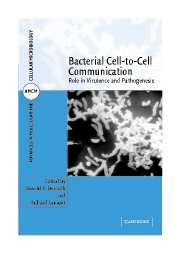Book contents
- Frontmatter
- Contents
- List of Contributors
- Preface
- 1 Quorum sensing and regulation of Pseudomonas aeruginosa infections
- 2 The Pseudomonas aeruginosa quinolone signal
- 3 Quorum-sensing-mediated regulation of plant–bacteria interactions and Agrobacterium tumefaciens virulence
- 4 Jamming bacterial communications: new strategies to combat bacterial infections and the development of biofilms
- 5 Quorum-sensing-mediated regulation of biofilm growth and virulence of Vibrio cholerae
- 6 LuxS in cellular metabolism and cell-to-cell signaling
- 7 LuxS-dependent regulation of Escherichia coli virulence
- 8 Quorum sensing and cell-to-cell communication in the dental biofilm
- 9 Quorum-sensing-dependent regulation of staphylococcal virulence and biofilm development
- 10 Cell-density-dependent regulation of streptococcal competence
- 11 Signaling by a cell-surface-associated signal during fruiting-body morphogenesis in Myxococcus xanthus
- Index
- Plate Section
- References
11 - Signaling by a cell-surface-associated signal during fruiting-body morphogenesis in Myxococcus xanthus
Published online by Cambridge University Press: 08 August 2009
- Frontmatter
- Contents
- List of Contributors
- Preface
- 1 Quorum sensing and regulation of Pseudomonas aeruginosa infections
- 2 The Pseudomonas aeruginosa quinolone signal
- 3 Quorum-sensing-mediated regulation of plant–bacteria interactions and Agrobacterium tumefaciens virulence
- 4 Jamming bacterial communications: new strategies to combat bacterial infections and the development of biofilms
- 5 Quorum-sensing-mediated regulation of biofilm growth and virulence of Vibrio cholerae
- 6 LuxS in cellular metabolism and cell-to-cell signaling
- 7 LuxS-dependent regulation of Escherichia coli virulence
- 8 Quorum sensing and cell-to-cell communication in the dental biofilm
- 9 Quorum-sensing-dependent regulation of staphylococcal virulence and biofilm development
- 10 Cell-density-dependent regulation of streptococcal competence
- 11 Signaling by a cell-surface-associated signal during fruiting-body morphogenesis in Myxococcus xanthus
- Index
- Plate Section
- References
Summary
INTRODUCTION
Over the past decade the perception of bacterial cells as autonomous individuals, each following their own agenda and not interacting with each other, has been replaced by the view that bacteria interact extensively both within and between species by means of intercellular signal molecules. Each of these signal molecules constitutes part of an information system that is constructed of four parts: the donor cell synthesizing the signal, the signal molecule, the recipient cell, and the output response. As in any other information system, the signal must be tailored to the talents of the recipient. A clear example of a tailor-made signal molecule is the C-signal molecule in Myxococcus xanthus. Most intercellular signals identified in bacteria are small (i.e. with a molecular mass of less than 1000 Da), freely diffusible molecules that are part of quorum sensing systems, which help bacterial cells to assess population size (90). However, that is not the case for the C-signal in Myxococcus xanthus. The C-signal is a 17 kDa cell-surface-associated protein and is thus non-diffusible, and it helps to guide M. xanthus cells into nascent fruiting bodies and to assess their position in a field of cells.
C-signal transmission occurs by a contact-dependent mechanism, i.e. it depends on direct contact between the donor and the receiving cell. The C-signal is used repeatedly during the starvation-induced formation of spore-filled fruiting bodies in M. xanthus. Early during fruiting-body formation, the C-signal induces the aggregation of cells into the nascent fruiting bodies.
- Type
- Chapter
- Information
- Bacterial Cell-to-Cell CommunicationRole in Virulence and Pathogenesis, pp. 269 - 300Publisher: Cambridge University PressPrint publication year: 2006



